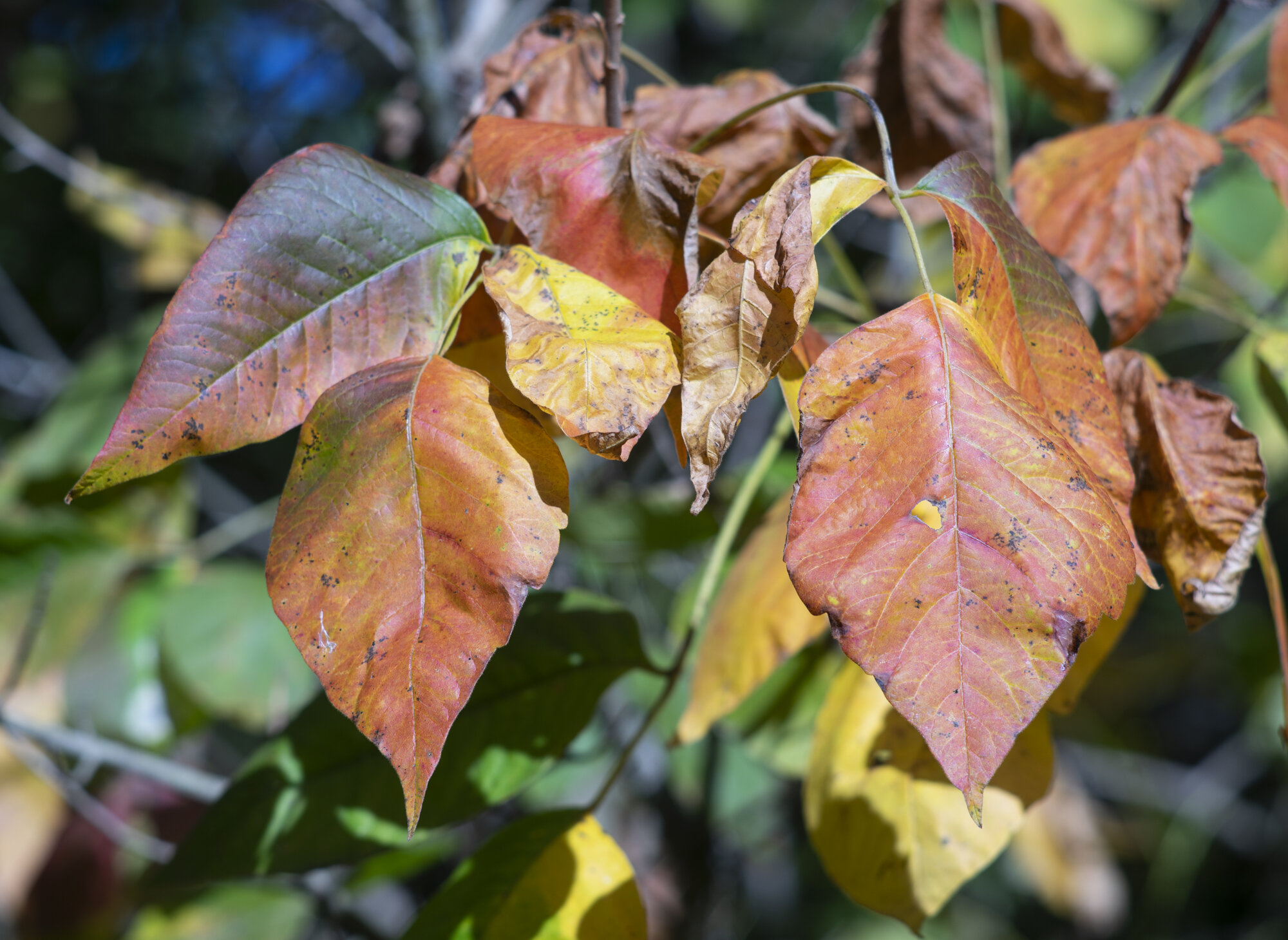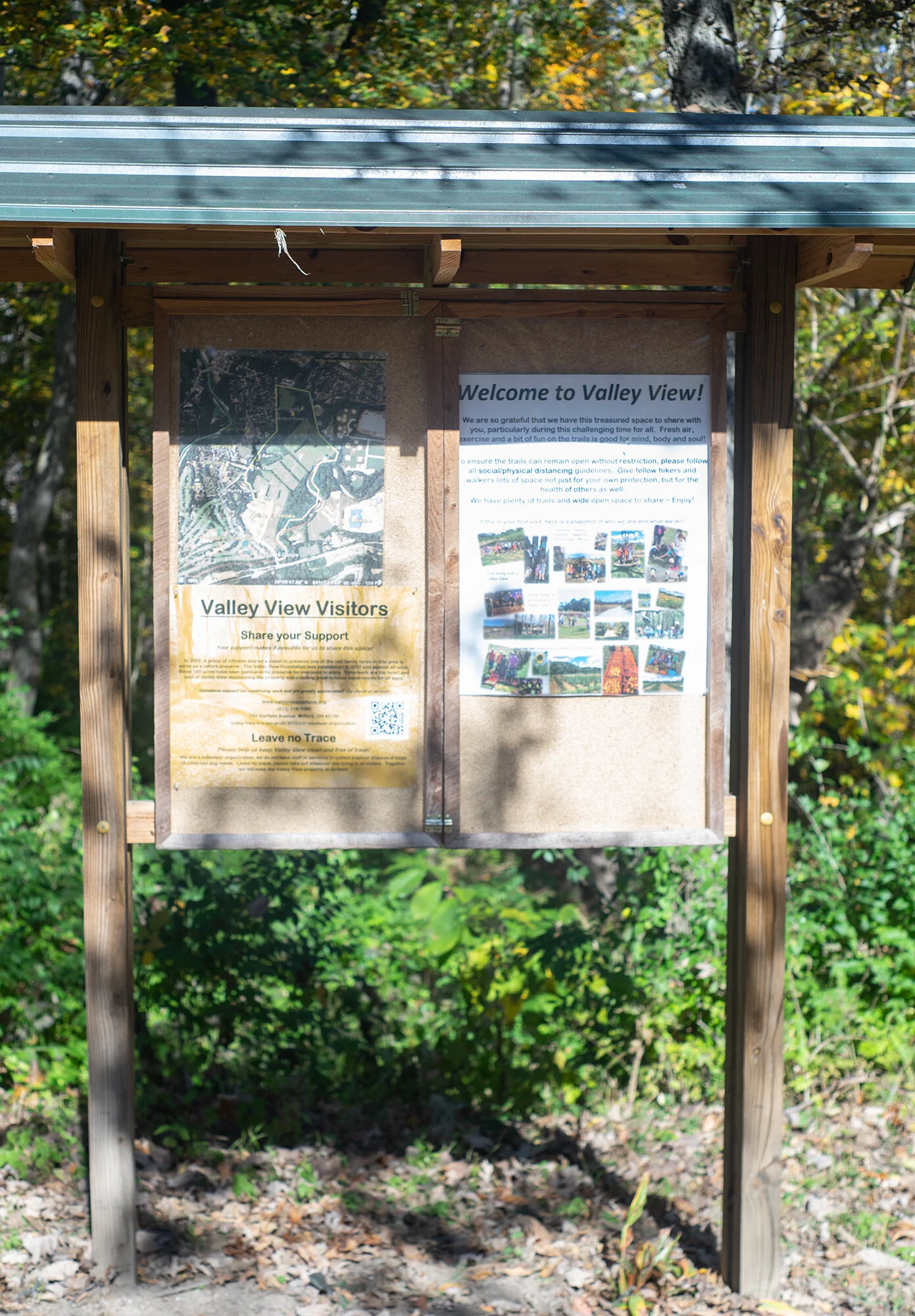
Fog in the valley blankets a trail in the evening.
Valley View
The Valley View Foundation purchased 190-acres of farmland in Milford, Ohio in 2002. Since then the non-profit has preserved the land and protected it from development. The farmland now serves as a nature preserve with hiking trails and a community garden. A variety of fundraisers, art shows, and community events are regularly held on the land. During the COVID pandemic there has been a push for outdoor and socially distanced recreation. This story outlines the daily activities and the history of this property.
The farmhouse, at 790 Garfield Ave. in Milford, Ohio, was built in the early 1800s by John Pollock, with stones found on the farmland. It still stands today, Nov. 3, with a new addition, and serves as offices and an event center.
Dave Schaff inspects a dryad saddle fungus growing out of a log on Nov. 5. This is Schaffs first time hiking at Valley View, but he loves “to hike in Hocking Hills … I like to notice all of the details.”
A sign at the North entrance of the property outlines social distancing guidelines, property rules, and ways to support and donate to the non-profit on Oct. 16.
Lori Walker looks over the East Fork Little Miami River on her first walk at Valley View on Oct. 16. Walker, who has lived nearby for two years said, “I can’t believe I haven’t been down here before, it’s really beautiful.”
Greg Elsner, of Mt. Lookout, Ohio, is a volunteer and founder of the Plant Rescue Project. He unloads a bale of straw from the trailer of Bob Laudeman's truck, on Nov. 6. Elsner struggles with the bale but exclaims "these things are 100 pounds! ... It's a labor of love."
Plant Rescue Project
In 2017 Valley View started their Plant Rescue Project. Greg Elsner and Chris Habel, Bob Laudeman’s son-in-law, and other co-founder of Valley View, spearheaded the project to keep a portion of the land agricultural and to keep produce plants out of landfills. Elsner takes care of the rescue garden and has “worked relationships with nurseries like Burger Farm, The Farm in Delhi, Natorp’s Nursery, and others. At the end of the growing season they have nothing to do with their plants, so they give them to us.”
With the help of volunteers working in the gardens and local nurseries donating their plants, the Plant Rescue Project has produced 1,000 to 6,000 pounds of produce that would’ve otherwise been lost. Elsner says “everything that grows out of it we give to La Soupe and different food pantries or soup kitchens, like Feed Our Flock. A couple years ago we donated around 6,000 pounds of produce, this year was a little less. We had some issues with the soil. So what we’re trying to do here is amend the soil because in this area we’ve depleted the soil. We’re trying to build a big huge compost pile.”
Elsner looks out for materials and plants headed for the trash to utilize in the garden.
“I saw this guy clearing out one of these little independent nurseries in front of Hyde Park Plaza. He was throwing all these straw bales and pumpkins out. I asked if I could have them and he said absolutely.”
Plants were in short supply this year.
“With COVID it was a big problem, nurseries were overwhelmed. Everyone thought they weren’t going to sell but actually it was the opposite. We were concerned we weren’t going to have any donations because places were all sold out. One of our big nurseries, Natorp’s, totally sold out and gave us nothing this year.”
A large barn stands on the land on Oct. 16. It was built by the Laudeman family in the mid 1900s to house cattle and machinery. The barn now serves as a storage area and a landmark for events. Lori Walker, or Milford, admires the barn on Oct. 16, with her dogs, Tina and Carl.
The Laudeman Family
Bob Laudeman didn’t become a farmer, but his connection to his familys land is apparent. He speaks about a profound experience he had walking through the field one morning.
“The prettiest sun I saw one time when I was down here in the spring, ice was all up in the trees, it was all around. We had a wet rain and all of the ice froze on the trees, and I was walking when the sun came up and I tell you, it was beautiful. It was all ice up there with the sun coming through, it was like an explosion.”
Laudemans great-grandparents and grandparents farmed the land from the early 1800s “up until the early 60s. I was in high school then. My grandpa farmed until he was around 80 with his little Ford tractor and a bunch of implements they converted from horse drawn to hook up to the back of a tractor. He didn’t have a lot of equipment … they had 30 cows they milked twice a day seven days a week. Everyday the truck would come by and pick up the big steel jugs. This plain used to flood a lot, there’d be 6 feet of water in the barn. We used to have to take the cows up to the top of the hill so they wouldn’t drown. They had chickens running all over the place. There was a co-op right in the middle of Milford. We had big cases of eggs we’d take in twice a week.”
Bob Laudeman, of Milford, Ohio, is a board member and co-founder of the Valley View Foundation. He is the sixth generation of the Laudemans, who farmed the south portion of the land. He stands for a portrait among bales of straw for compost on Nov. 6. He jokes about being “the garbage man,” as he tends to the compost, but he also takes “care of the farming equipment.”
A honey fungus (Armillaria sinapina) grows at the base of a log on Oct. 28. This is a pathogenic fungus and the mycelium is bioluminescent.
Clustered bonnet fungus (Mycena inclinata) grows on a log covered in lichen on Oct. 28.
Chicken of the woods fungus (Laetiporus sulphureus) grows on a log on Oct. 28. Chicken of the woods is edible and considered a delicacy.
The Gatch Family
The Gatch family purchased the farm in 1850, and lived in the stone farmhouse that still stands on the North end of the Valley View property, once called Arrowhead Farm. Cathy Gatch, 68, is the last member of the Gatch family still living on the land. Her “grandparents built this barn back in the 40s. They didn’t do a lot of farming, but they did enough. I’d like to see more farming on the land now.”
She began the Milford Pottery business in 1978 in downtown Milford, and moved her studio to her grandfathers barn in 1985. Gatch remembers growing up on the land and “used to have a garden out to the side of the barn.”
“It’s really pretty back here after the first frost, when the leaves change color.”
Cathy Gatch, creator of Milford Pottery, stands behind a barn her grandfather built, on Oct. 30. “This used to be an old dairy barn. I haven’t been working in my studio out here for a long time, but I used to do a lot of production work.”
The South Milford Artisan Show
The Milford Pottery barn has been hosting the South Milford Artisan Show since the 90s. The show showcases a variety of painters, jewelry makers, writers, textile dyers, and sculptural artists.
The Milford Pottery barn, located at 780 Garfield Ave. Milford, Ohio, on Oct. 24. The barn was built by the Gatch family in the 1940s.
The Milford Pottery barn hosts the South Milford Artisan Show on Oct. 25. Booths are set up in what used to be animal stalls.
Susan Gilbert stands in front of her eco-dyed silks for sale on Oct. 14. Gilbert uses “pigmented plants like marigolds and walnuts and I wrap them in tight bundles to absorb the dyes.”
Beekeeping
The Valley View property is currently home to three honey bee colonies, maintained by volunteers from the community. Raising honey bees on the land is an homage to the fields agricultural history. The land is also home to an abundance of wildflowers, including stiff goldenrod, Canadian goldenrod, bee balm, and milkweed, giving the bees plenty to eat.
Dried milkweed seed pods in the North field have cracked open and exposed their seeds on Nov. 3.
Dormant stiff goldenrod flowers and seeds are tangled in invasive honeysuckle vines on Nov. 6.

Vibrant fall foliage on Oct. 16 2020.
















